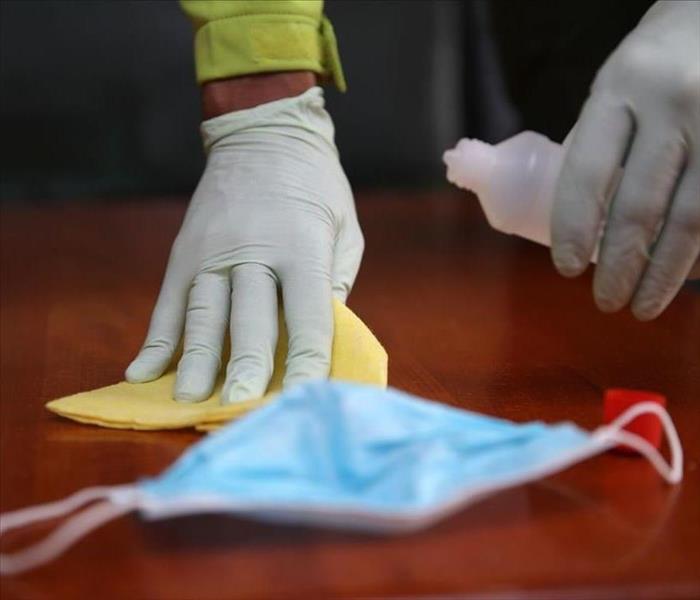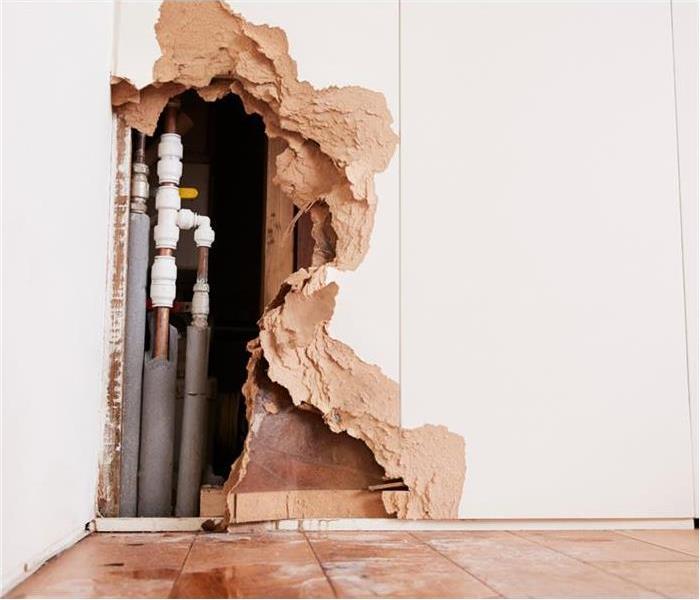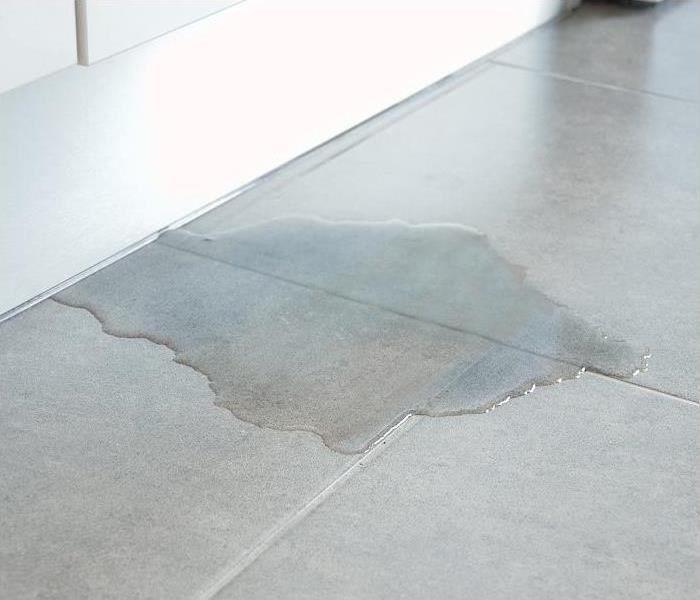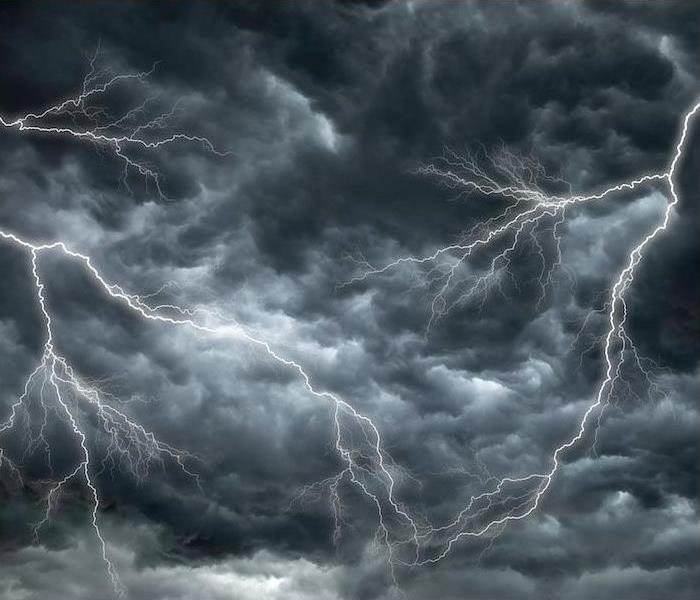Archived Blog Posts
A Guide to Maintaining Infection Disease Control in the Workplace
1/21/2021 (Permalink)
While work may look a lot different for some people amidst the COVID-19 pandemic, people returning to their workplace want to ensure it is a clean, safe place to be.
There are several steps you can take to help maintain control over infectious diseases within your office.
What is infectious disease control?
Very simply put, infectious disease prevention and control is a method of cleaning and minimizing the spread of contagious disease.
Why is it important in the workplace?
Ensuring that a workplace is safe and clean can contribute greatly to productivity and loyalty within you employees. Office spaces, especially smaller scaled, can be some of the easiest places for germs to spread. Everyone often touches the same high traffic touch points, visits the same break room, works in close corners, etc. and it is critical these places are kept clean to minimize the spread.
The Plan
- Plan Accordingly. The first thing that you should do is to come up with an infection control plan. Involve a management team to work more closely with employees and enforce any established workplace policies and procedures for infection control.
- Remove Common-Use Items. Something as simple as removing common items like magazines, community snack baskets, pens, etc. can greatly help slow the spread of any germs.
- Encourage Basic Etiquette. Encourage employees to practice the basic etiquette of covering their mouths when they cough or sneeze. Provide boxes of tissues and disinfectant wipes in common rooms where they interact with more people. At the same time, discourage them from sharing personal items like cups, glasses, and cutleries where they can easily transfer their respiratory droplets to other people. Most importantly, encourage employees to stay home if they feel under the weather.
- Basic Sanitation. The way to prevent the spread of infection is to provide ways for your employees to rid themselves of germs by putting up clean handwashing facilities and sanitation stations equipped with alcohol or alcohol-based hand sanitizers.
SERVPRO of Queen Anne's, Kent & Caroline Counties offers commercial and residential COVID-19 cleaning services that range from expected exposure to preventative cleaning. Allow us to be part of your plan and ensure your work place is a safe and healthy environment! 443-737-8776
Choosing Home Restoration Services in Advance | SERVPRO® of Queen Anne’s, Kent and Caroline Counties
1/21/2021 (Permalink)
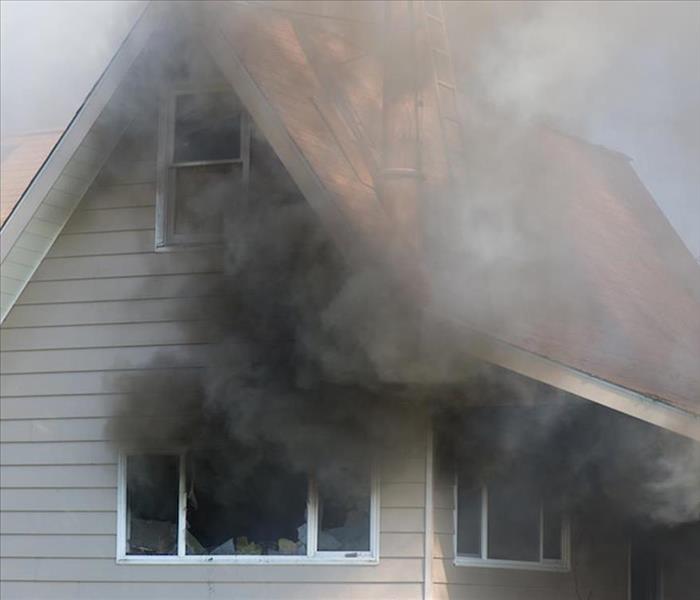 If you’ve been affected by a fire, reach out to us right away! We are here 24/7 to help you recover.
If you’ve been affected by a fire, reach out to us right away! We are here 24/7 to help you recover.
Fires can happen regardless of the weather, which is why fire preparedness is so important throughout the year. However, experts like the Red Cross recommend being extra prepared in winter months as that is when the rate of home fires peaks throughout the United States.
Planning for both during and after a fire is extremely important. Create an emergency escape plan so your entire family knows what to do the moment a fire breaks out. For afterward, knowing what restoration company to call can help things move along quickly so you can reclaim your home.
Choosing Us for Fire Restoration
It goes without saying that you want the company you choose for fire restoration to do a good job, but it is important to know what that means. Working with a company that will compromise on quality or service offerings can create further headache down the road—that is why we offer a three-step fire cleanup process to take care of everything for you:
Structural Cleaning
The structure of a home is made up of many important elements, all of which can be damaged in a fire. Beginning with establishing the extent of the damage with pretesting, we will then bring in the tools we need for restoration. We will clean and repair the area, and can even prepare soot-covered walls for paint application.
Content Cleaning
Replacing your items after a fire is often costlier than having them restored, which is why we make sure to have the tools on hand to clean a variety of belongings. Utilizing both wet and dry cleaning equipment, we can handle a variety of items from wood furniture to area rugs to electronics. This allows you to keep the items you love while ensuring they are cleaned, deodorized and safe to use.
Deodorization Services
Fires can leave behind smoke and soot odors that linger unpleasantly. Air scrubbing equipment ensures these hazardous particles are removed instead of simply covering up odors with fragrances.
How to Prevent Water Damage
1/19/2021 (Permalink)
Although water losses can occur despite our best preparation efforts, there is a lot that home owners can do to try to prevent it as well as lessen the damage.
We have a few tips for if you find yourself in a water damage situation:
• Shut off the water if possible or contact a qualified party to stop the water source.
• Turn off any circuit breakers for the wet areas of the property once access to the power distribution panel is safe from electrical shock.
• Remove as much of the excess water as possible by mopping and blotting.
• Wipe excess water from wood furniture after removing lamps and tabletop items.
• Remove and prop-up wet upholstery cushions for drying.
• Place aluminum foil or wood blocks between furniture legs and wet carpeting.
• Remove any art, technology, important documents, and other materials that are valuable or sensitive to moisture to a safe, dry area.
• Hang draperies with coated hangers to avoid contact with wet carpeting or floors.
• Hang furs and leather goods to dry separately at room temperature.
We also have a few tips for what NOT to do:
• Enter rooms with standing water where electrical shock hazard may exist.
• Enter affected areas if electrical outlets, switches, circuit breakers or electrical equipment are exposed to water. Always avoid electrical shock hazards.
• Leave books, newspapers, magazines or other colored items on wet carpet or floors to cause staining.
• Leave Oriental rugs or other colored rugs on any wet surface- may cause colors to bleed and stain.
• Use your household vacuum cleaner to remove water, possibly causing electrical shock or damage to the vacuum cleaner.
• Use TVs or other appliances while standing on wet carpets or floors, especially not on wet concrete floors.
• Turn on ceiling fixtures if ceiling is wet or enter rooms where ceilings are sagging from retaining water.
If you or someone you know finds themselves in a water loss situation, call SERVPRO of Queen Anne's, Kent & Caroline Counties to help remediate the problem! 443-737-8776
Chimney Safety
1/15/2021 (Permalink)
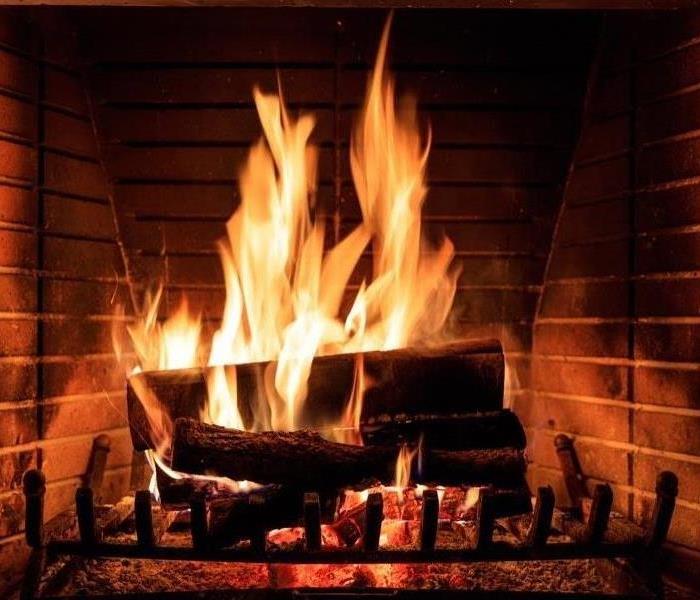 Always educate yourself on fire safety!
Always educate yourself on fire safety!
Chimney fires happen every year and more often than you'd probably suspect. It's incredibly important that you're chimney is prepped and ready for a fire and that you are safely and properly maintaining the fire once lit.
Prior to using your chimney you should get it professionally inspected.. This will ensure that your flute is working properly and everything is safe and ready to go!
Once you have the OK, here are a few tips to safely enjoy fires all winter long!
- Burn fires that are proportionality sized for YOUR fire place. This makes it much easy to have the fire under control!
- ONLY burn proper wood and materials. Plastic and styrofoam should never be burned within a fire- especially indoors.
- Make sure there is a significant draft when burning a fire. However, be weary when choosing to light a fire on especially windy days. The draft may cause smoke to linger within your house rather than up and out of the chimney.
If you suspect your fireplace is a hazard or you've lit a fire that has become to large to handle, you should call 911 to properly handle the situation.
If you or someone you know has suffered the unfortunate instance of fire damage, allow us to take care of the damage and work to make it "Like it never even happened."
Halloween Fire Safety Tips
10/30/2020 (Permalink)
 Happy Halloween!
Happy Halloween!
Happy Halloween!! Although Halloween and other holidays may feel a little different this year, we are hoping you and your loved ones are still able to celebrate and have fun in a safe way! Aside from health safety, we are here to share some important fire safety tips for you on Halloween!
- Ensure that any decorations such as hay bails or dried corn stalks are away from open flames or any light fixtures including open light bulbs, string lights, etc.
- Consider switching flames our for LEDs. There are a TON of faux candles/flame options available and they are a much safer alternative!
- While your costume is likely not flame resistant, it is important to be aware of the details of your costume including long strings, tassels, tails, etc. that may easily catch fire if near one. If this does happen, make sure to stop, drop & roll!
- If having a bonfire, make sure that you are a safe standing distance, there are no low over hanging branches, and ensure you have a safety plan incase of any accidents.
As always, we are Here to Help and want to make sure you and yours have a fun holiday weekend! Happy Halloween from your friend at SERVPRO of Queen Anne's, Kent & Caroline Counties.
What are the Differences Between Janitorial Services and Commercial Cleaning for COVID-19?
6/22/2020 (Permalink)
SERVPRO of Queen Anne's, Kent & Caroline Counties is being called on by numerous business and community leaders to perform the necessary bio-remediation services to clean and sanitize their properties for COVID-19.
SERVPRO of Queen Anne's, Kent & Caroline Counties professionals are uniquely prepared during this unprecedented time to clean and sanitize your business according to the protocols set forth by the CDC. We have the experience in dealing with biological contaminants and we go beyond the scope of work that regular janitorial staff perform on a daily basis.
Here are 3 things that show how our cleaning is different than general janitorial cleaning:
IICRC Certified. The Institute of Inspection, Cleaning and Restoration Certification (IICRC) is the non-profit certifying body for the cleaning and restoration industry. Not only is SERVPRO of Annapolis/Severna Park IICRC certified as a firm, but most members of our staff carry several IICRC certifications.
Cleaning Experts. The CDC encourages cleaning of high-touch surfaces such as counters, tabletops, doorknobs, light switches, bathroom fixtures, toilets, phones, keyboards, tablets, and tables at a minimum. Most of our cleaning tactics will go beyond the scope of work that regular janitorial staff perform on a daily basis
The CDC also recommends regular cleaning of the following areas/items:
- Kitchen/Food Areas
- Bathrooms n Schools/Classrooms
- Offices
- Retail Spaces
- Water Fountains
- Shelving/Racks
- Sales Counters
- Carpets and Rugs
- Stair Handrails
- Elevators and Escalators
- Playground Equipment
- Fitness Equipment
Cleaning Products. Multiple products in the SERVPRO product line meet this standard and carry the EPA-registered emerging pathogens claims. While there is currently no product tested against this particular strain of the Corona Virus, we are following all guidelines as provided by the CDC and local authorities.
Our proprietary cleaning agents, Benefect and Shockwave, are EPA-certified, hospital-grade disinfectants that have demonstrated effectiveness against viruses similar to Coronavirus (SARS-CoV-2/COVID-19) on hard, non-porus surfaces.
We carry multiple hospital-grade disinfectants and provide our personnel with proper PPE. Not only does this protect everyone, but it also protects the building and people in it.
Call today- 443-SERVPRO
We are Cleaning Experts
6/11/2020 (Permalink)
 Call Today for a Proactive Cleaning
Call Today for a Proactive Cleaning
SERVPRO is Here to Help during this time of need
During this unprecedented time caused by the global pandemic of corona-virus, this is a reminder to our customers that we are specialists in cleaning services, and we adhere to the highest cleaning and sanitation standards.
Specialized Training
We are prepared to clean and disinfect your home or business, according to protocols set forth by the Centers for Disease Control and Prevention. We have years of experience in dealing with biological contaminants, and we will go beyond the scope of work that regular janitorial staff perform on a daily basis.
Specialized Products
The CDC recommends usage of a labeled hospital-grade disinfectant with claims against similar pathogens to the coronavirus. Multiple products in the SERVPRO product line carry the EPA-approved emerging pathogens claims. While there is currently no product tested against this particular strain of the coronavirus, we are following all guidelines as provided by the CDC and local authorities.
Call Today for a Proactive Cleaning
If your home or business needs deep cleaning services, call the experts today – SERVPRO of Queen Anne's, Kent & Caroline Counties
443-SERVPRO (737-8776)
Sources:
https://www.cdc.gov/coronavirus/2019-ncov/hcp/guidance-prevent-spread.html?CDC_AA_refVal=https%3A%2F%2Fwww.cdc.gov%2Fcoronavirus%2F2019-ncov%2Fguidance-prevent-spread.html
https://www.cdc.gov/coronavirus/2019-ncov/specific-groups/guidance-business-response.html
When Storms Cause Destruction, You Can Depend on Us | SERVPRO® of Queen Anne’s, Kent and Caroline Counties
3/12/2020 (Permalink)
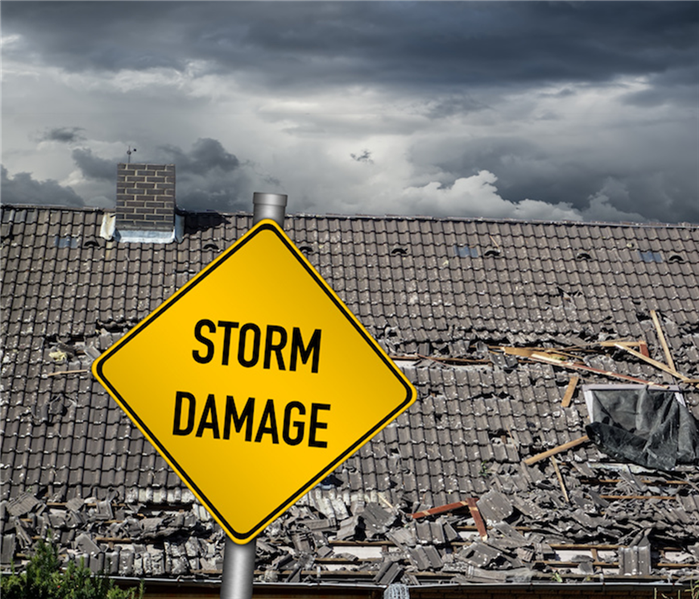 If you have experienced storm damage or want to learn more, you can call us 24/7 for more details.
If you have experienced storm damage or want to learn more, you can call us 24/7 for more details.
When storms are forecasted to roll through, it is common for homeowners to feel concern. Any storm brings with it the potential for house damage, and storm-related damages cost $2 billion for homeowners in 2018.
Storm damage is consistently one of the leading causes of house insurance claims, causing complicated and expensive problems for those in their wake.
Having a plan in place for post-storm restoration is a smart move, and we can help you recover from the damages. When you call us after a storm, you can depend on us for friendly, efficient service and much more.
What You Can Count on When You Choose Us for Storm Restoration
A Restoration Plan With Everything Accounted For
The damages from storm fronts require a holistic approach to be handled fully. Structural damage can beget water damage that leads to mold, which is why we make sure we carry full certifications and expertise in all of these areas to ensure we can handle whatever nature brings your way.
A Qualified Crew Working on Your Home
Our technicians are responsible for the quality of service our customers receive, which is why we care deeply about their training and education. By using the Institute of Inspection Cleaning and Restoration Certification standards as our guideline, we have designed a comprehensive training regimen that includes initial education as well as developmental seminars and opportunities for our entire workforce.
An Adequate Number of Resources
As a local business, we have the benefit of getting involved with the community and caring deeply about our neighbors. However, when severe storms impact the area, we are able to scale our resources to match the demand thanks to our national SERVPRO® partners. This means that regardless of how large-scale the damage is, everyone will receive the attention they need.
A Restoration Experience You Can Trust
Following a large band of thunderstorms or other disaster, scams are unfortunately extremely common. It is wise to be wary of any “new” or “from out of town” companies that try and win your business with false promises, and instead go with an established leader in restoration such as SERVPRO®.
How You Can Reduce the Fire Risks That Could Affect Your Business | SERVPRO® of Queen Anne’s, Kent and Caroline Counties
2/25/2020 (Permalink)
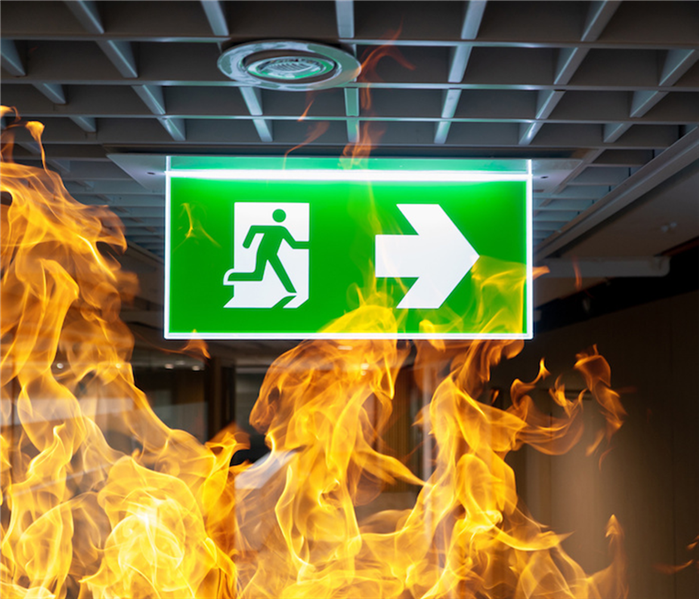 If your business has experienced a fire, we’re here 24/7 to respond and begin restoration. Call us today to learn how we can help you.
If your business has experienced a fire, we’re here 24/7 to respond and begin restoration. Call us today to learn how we can help you.
Being aware of any potential threats to your business is a smart move as a business owner, and it is important that you consider emergencies in that category as well. Commercial fires can be extremely harmful for businesses, leading to permanent closures in the most severe of scenarios. However, by doing what you can in advance to reduce your risks and make sure you are prepared, you can reduce the likelihood of a fire occurring at all.
In order to provide a helpful reference guide, we have assembled the top fire safety tips that business owners should know. By understanding your codes, specific risks and how to prepare your staff, you can make big strides toward your fire safety goal.
Fire Safety Tips for Every Business Owner to Follow
Follow code guidelines and inspection schedules. The first step is to understand fire safety codes that the National Fire Protection Association has published for commercial properties to adhere to. These will cover the equipment you need, how often to inspect it and any other standards that should be followed for your business.
Identify your specific risks. Every commercial risk profile will look a bit different depending on the business, which is why determining your own specific business risks is so vital. Being aware of any equipment, chemicals or other things that are present that could increase your fire risk will help you make sure you are taking the proper precautions.
Create (and practice) a fire evacuation plan. Preventing panic when a fire alarm sounds is essential to getting everyone in the building safely evacuated. One of the best ways to do this is by making sure everyone is prepared by hosting regular fire safety drills with your staff. This way, when the alarm sounds for real, they will know exactly what to do and can remain calm.
Have regular fire safety seminars with staff. Helping your staff review the general fire safety guidelines of your building is a great supplement to regular fire drills. The location of fire alarms and extinguishers, as well as any special protocols, is useful knowledge that can help everyone who works in the building feel more prepared.
Prevent Water Damage From Appliances | SERVPRO® of Queen Anne’s, Kent & Caroline Counties
1/31/2020 (Permalink)
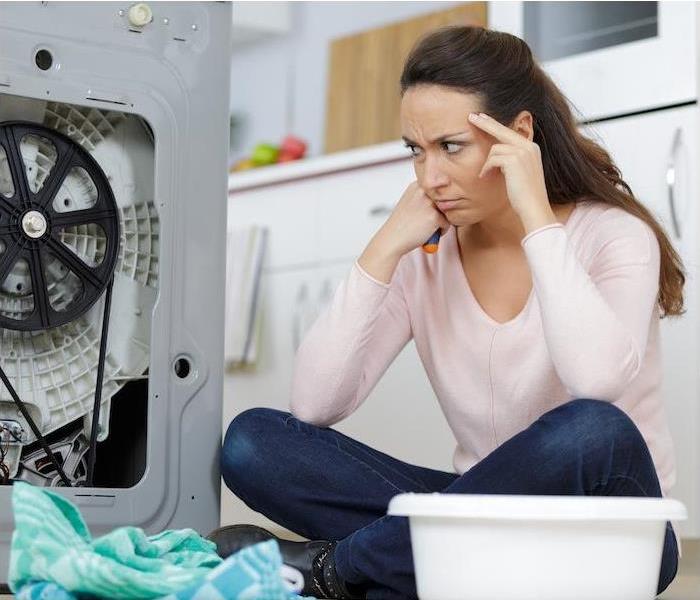 If your home has been impacted by water damage or you’d like to put a plan in place in case it happens to you, contact us to learn how we can help.
If your home has been impacted by water damage or you’d like to put a plan in place in case it happens to you, contact us to learn how we can help.
Regardless of the source of the issues, water damage can be a complicated and costly thing for homeowners to experience.
When that water damage comes from household appliances, however, it can be even more complicated. Because appliances can easily hide water damage, it is important to do regular inspections to avoid the problem worsening without you knowing.
Perform These Regular Appliance Inspections to Prevent Leaks
Hot Water Heater
Hot water heaters are fairly durable appliances overall, but their smaller components can fail early in their life. Hoses and seals are common points for leakage, so checking in often (especially if you notice decreased performance in your unit) is key to preventing damage.
Refrigerator
Refrigerators are so rarely moved away from the wall that they can harbor serious levels of water damage without anyone being aware of it. Their water lines can crack or develop tears, leading to seepage that can become a much larger problem when left untreated. Make inspecting behind the refrigerator a regular part of home maintenance to be safe.
Dishwasher
Just as with refrigerators, dishwashers are rarely moved, so it is good to get in the habit of checking behind them. They can have much larger leaks, which often will not be eligible for insurance coverage depending on the unit. Because of how much water dishwashers use, it is smart to check frequently for leaks to avoid large damages.
Washing Machine
The hoses that connect the washing machine to the water supply should be checked once a month for leaks or any signs of wear and tear, as they are common culprits of leaks. Even if they look perfectly fine, they should be replaced every five years to be safe.
Air Conditioner
An air conditioning unit creating condensation is normal, and generally, this moisture is quickly drained away. However, issues with these drains or water lines can lead to problems within the unit and water damage to the surrounding structures. Following your regular maintenance schedule and checking on your unit regularly during the warm months is the best prevention method for this.
Reducing Disaster Risk at Your Small Business | SERVPRO® of Queen Anne’s, Kent & Caroline Counties
1/3/2020 (Permalink)
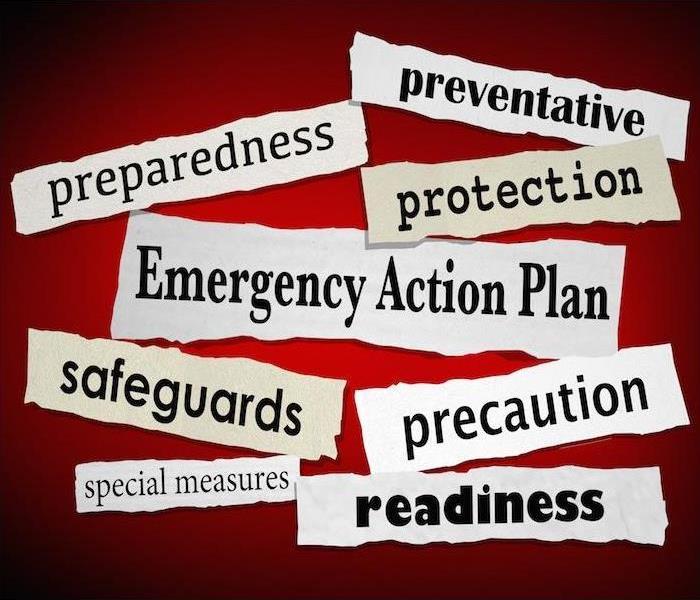 If you need to pick a commercial restoration company that’s right for you, call us today! We can tell you all about what sets our process apart.
If you need to pick a commercial restoration company that’s right for you, call us today! We can tell you all about what sets our process apart.
Knowing the risks that are likely to affect your business is an important aspect of planning ahead as a small business owner. While you likely consider economic and market factors, it is also good to consider environmental risks as well—namely, natural disasters.
Because natural disasters have been happening more frequently in recent years than ever before, it is a wise choice to put a preparedness plan in place. Understanding what to do in the crucial time after a disaster is one of the best ways to lessen the risk one will pose to your business operations.
Preparedness for Disasters at Your Business
- Double-Check Your Insurance
While many business owners might assume that their general business policy is adequate, that is unfortunately not always the case. Many business owners find themselves having to purchase supplemental policiesto be fully protected from the types of damages that are likely from a disaster. Therefore, talking to your insurance agent in advance is a wise choice in order to ensure your coverage is adequate. - Create Your Action Plan
Obeying evacuation orders quickly and safely is one of the most important things you can do in a natural disaster, and having an emergency action plan makes this much easier. Knowing what evacuation route to take, where to seek safety and medical attention if necessary and how to take provisions for your business in the moments before you leave will make all the difference in your personal and commercial safety during this stressful time. - Rehearse Drills and Prepare Staff
Helping your employees be prepared for a disaster is a wise leadership tactic that will increase safety and decrease your liability at the same time. Prepare by having regular drills during work hoursso everyone within the company knows their roles and procedures in a natural disaster scenario. - Choose a Restoration Company to Work With
A quick recovery after a disaster is the main focus for business owners, as they are well aware of how devastating even a small lapse in operations can be. That is why choosing a commercial restoration company in advance when you have time to do research and ask questions is such a wise choice. Seek out a company that can guarantee you a quick response regardless of when your damage occurs and perform the work efficiently and effectively so you can get back up and running as quickly as possible following a disaster.
Damages to Homes From Floods | SERVPRO® of Queen Anne’s, Kent and Caroline Counties
12/27/2019 (Permalink)
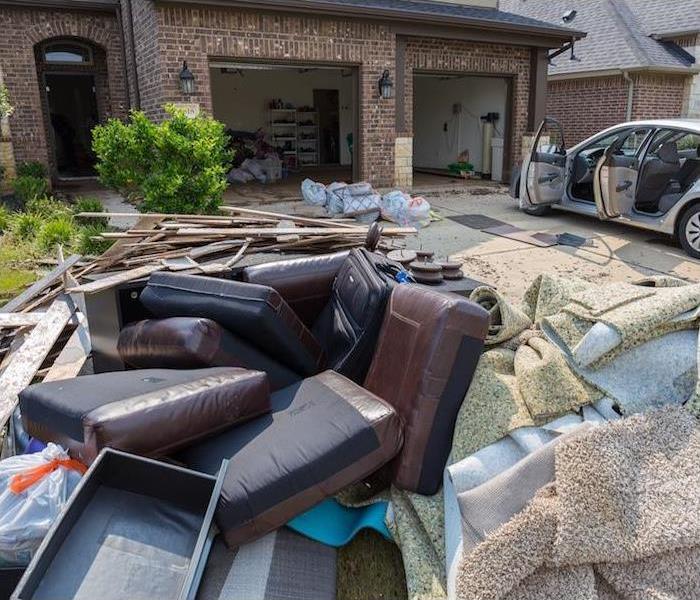 f your home has been affected by a flood, we’ll be here to help you! Give us a call 24/7 to learn about our certified flood restoration process.
f your home has been affected by a flood, we’ll be here to help you! Give us a call 24/7 to learn about our certified flood restoration process.
For many homeowners, planning to stay safe from things like severe weather and house fires might feel like second nature, but it is important to remember the dangers of flooding, too. Once considered a fairly isolated occurrence, the rate of flooding is on the rise, meaning the rate of preparedness should rise to meet it.
Floods are caused by a variety of events and no two are the same, meaning the issues they can cause is also variable. In the spirit of helping homeowners be more prepared, we’ve done the research on the most common types of house damage floods cause.
Most Common Types of Flooding Damage to Homes
Foundational Damage. When the soil underneath a home becomes saturated with floodwater, it can begin to swell and shift below the foundation, causing the home to swell and shift as well. This can lead to uneven flooring, off-kilter door frames and cracks in walls.
Drywall Damage and Mold. Water-damaged drywall and mold go hand-in-hand, so a drywall replacement of any panels that have come into contact with floodwaters is typically in order.
Insulation Saturation. The typical home insulation is made from a highly absorbent material that can hold a large amount of floodwater. Water-damaged insulation will have its effectiveness greatly reduced and can also lead to mold growth within the walls of the home.
Temporary Frame Swelling. The frame of most houses is constructed with solid lumber and can maintain its integrity even when a flood has come into contact with it. While some swelling of the wood may occur, this is normal and will usually subside once a thorough drying is complete.
Appliance Ruining. The insulation in appliances is what helps them work effectively, but it can also make using them to be dangerous after a flood. The good news is that not all appliances are affected the same, so you should get a professional opinion before throwing any out.
Furniture Damage. Damage to furniture following a flood is typically found in mattresses, upholstered pieces and items constructed from composite boards. Furniture made from metal, glass or acrylic will generally be suitable for use again after a thorough cleaning.
Fire Prevention Tips for Winter
12/20/2019 (Permalink)
 If your home has been impacted by a fire, call us right away. We are leaders in restoration and can help you recover quickly after a fire occurs.
If your home has been impacted by a fire, call us right away. We are leaders in restoration and can help you recover quickly after a fire occurs.
Preparing for winter weather involves a lot of things, and it is important to add fire safety to that list as well.
Winter is the top time for fires to occur in homes, due to a variety of factors that contribute to making them more likely. By understanding common fire causes and prevention tips, individuals can have a safe season.
Why There Is an Uptick in House Fires
An Increase in Cooking
The NFPA findings repeatedly point to cooking as the leading reason house fires begin during all times of the year, with a sharp increase during the winter months. Being safe during cooking is an important thing to consider at any time of year, but especially during the winter.
The Risk of Heaters
Utilizing heating methods such as space heaters and wood stoves is common in the winter, but safety issues with these methods make them the second-most common fire starter as well. Making use of safety features, never leaving flames unattended and ensuring all heaters are equipped with emergency shut-offs will have a big impact in fire safety.
Candles and Decorations
Holiday decorations featuring candles and electronics are great for festive events, but it is important that they are used with caution. Never leave lit candles unattended to avoid the flame spreading to other objects. For decorations with electrical features, be sure to inspect the elements for wear and tear before use to prevent the risk of fire.
Preventing Winter Fires
Keeping winter fire safety tips in mind is an important part of having a fire-free season. Be sure to understand what events are likely to cause a fire in order to utilize extra caution, and keep these prevention tips in mind as well:
- Check smoke alarms once every 30 days and replace every 10 years.
- Always monitor open flames.
- Select space heaters with automatic shut-offs in case they tip over.
- Utilize a screen every time you use a fireplace.
- Draft and practice an emergency escape plan with your household.
Choosing Home Restoration Services in Advance | SERVPRO® of Queen Anne’s, Kent and Caroline Counties
12/6/2019 (Permalink)
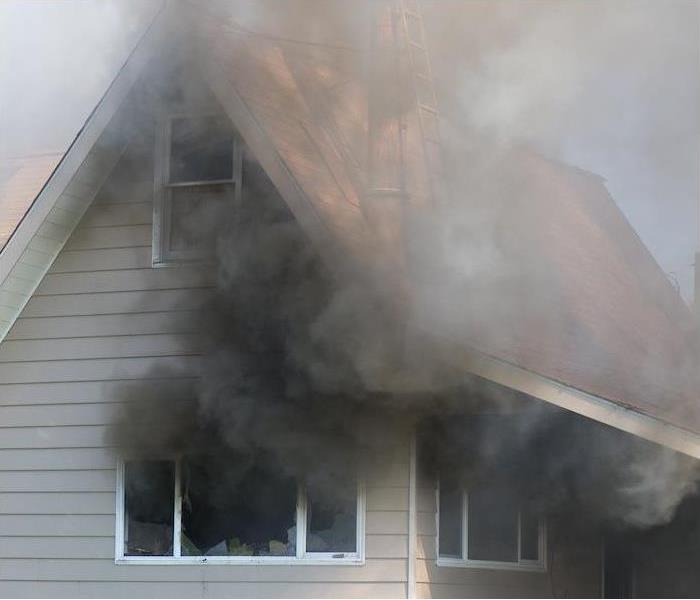 If you’ve been affected by a fire, reach out to us right away! We are here 24/7 to help you recover.
If you’ve been affected by a fire, reach out to us right away! We are here 24/7 to help you recover.
Fires can happen regardless of the weather, which is why fire preparedness is so important throughout the year. However, experts like the Red Cross recommend being extra prepared in winter months as that is when the rate of home fires peaks throughout the United States.
Planning for both during and after a fire is extremely important. Create an emergency escape plan so your entire family knows what to do the moment a fire breaks out. For afterward, knowing what restoration company to call can help things move along quickly so you can reclaim your home.
Choosing Us for Fire Restoration
It goes without saying that you want the company you choose for fire restoration to do a good job, but it is important to know what that means. Working with a company that will compromise on quality or service offerings can create further headache down the road—that is why we offer a three-step fire cleanup process to take care of everything for you:
Structural Cleaning
The structure of a home is made up of many important elements, all of which can be damaged in a fire. Beginning with establishing the extent of the damage with pretesting, we will then bring in the tools we need for restoration. We will clean and repair the area, and can even prepare soot-covered walls for paint application.
Content Cleaning
Replacing your items after a fire is often costlier than having them restored, which is why we make sure to have the tools on hand to clean a variety of belongings. Utilizing both wet and dry cleaning equipment, we can handle a variety of items from wood furniture to area rugs to electronics. This allows you to keep the items you love while ensuring they are cleaned, deodorized and safe to use.
Deodorization Services
Fires can leave behind smoke and soot odors that linger unpleasantly, but that is not the worst of it—they can cause negative health effects, too. That is why we have air scrubbing equipment to ensure these hazardous particles are removed instead of simply covering up odors with fragrances.
Frozen Pipes: How To Avoid Freezing Pipes & What To Do If It Happens
11/13/2019 (Permalink)
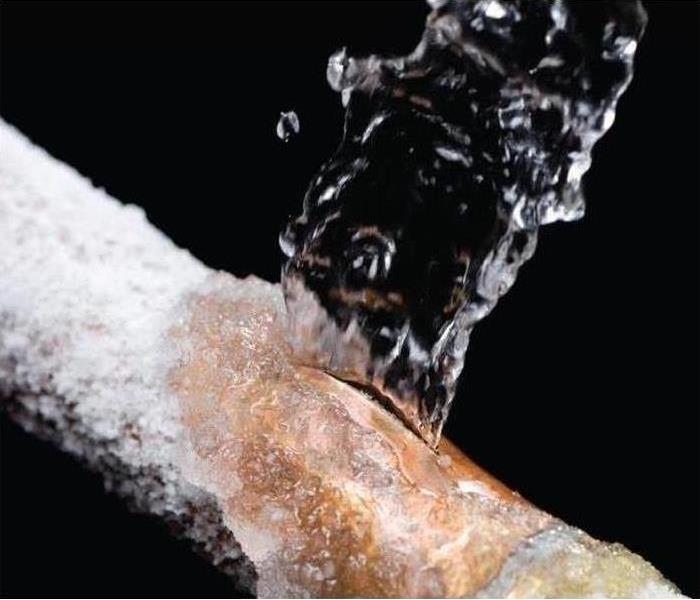 It's not too late to prep your property for upcoming winter conditions!
It's not too late to prep your property for upcoming winter conditions!
As we all know, we recently had our first significant below freezing temperatures sweep over several areas in Maryland. It is not too late to better prepare for the risks that winter weather poses on your home and/or business.
As temperatures drop, water expands and freezes. Frozen water within pipes, whether they be plastic or metal, causes immense pressure build ups and can leave you with busted pipes and costly repairs. Although frozen pipes are a common occurrence, they are easily preventable.
SERVPRO offers these tips for preventing frozen pipes and mitigating any damage that they can cause.
Preventing Frozen Pipes:
- Disconnect any outdoor hoses
- Drain any in-ground irrigation systems
- Close any indoor valves that supply water outside and leave the outdoor valves open to allow for any excess water to drain out
- Caulk around pipes where they enter the house as well as any visible cracks on the interior and exterior of the property
- Add extra insulation to exposed pipes around the property. Pay close attention to pipes that are in unheated areas such as the basement, crawl space, attic, garage, etc.
- Maintain a consistent temperature throughout the inside of the property both day & night. This will give extra protection to pipes.
- In significantly low temperatures, let the faucet slightly drip- running water is much less likely to freeze.
- If expected to be away for an expected period of time leaving the property unattended, leave the heat on at a temperature no lower than 55° F
- Identify locations of shut-off valves in case of a burst pipe to quickly attend to the situation and lessen the potential water damage
Mitigating a Frozen Pipe:
- Leave water sources flowing as you are treating a frozen pipe- as water begins to flow it will help melt the ice within the pipe
- Gradually apply heat to the effected pipe. Consider using an electric heating pad to wrap the pipe, an electric hair dryer, a space heater set up at a safe distance from any flammable material, or wrapping a towel soaked with warm water around the pipe. Although it seems easier, do not use a blowtorch, a kerosene or propane heater, or any open flame device. These tools can cause even more damage and potentially start a fire.
- Apply the heat until you have restored and maintained full water pressure
- Call a licensed professional if you are unable to identify the frozen pipe, if the pipe is not accessible, or if you are unable to thaw the pipe
If a Pipe Bursts:
- Shut off the main water valve. Your shut off should be clearly marked with a tag of some sort. If it is not easily located, call SERVPRO of Queen Anne's, Kent & Caroline Counties to help.
It is critical that you treat any and all damage caused by frozen pipes- especially water damage. Water damage can lead to other issues including mold growth and structural damage. If your property has been effected by freezing temperatures, reach out to us right away! SERVPRO of Queen Anne's, Kent & Caroline Counties is here 24⁄7 to help you recover.
How Business Owners Can Prepare for Floods | SERVPRO® of Queen Anne’s, Kent & Caroline Counties
11/8/2019 (Permalink)
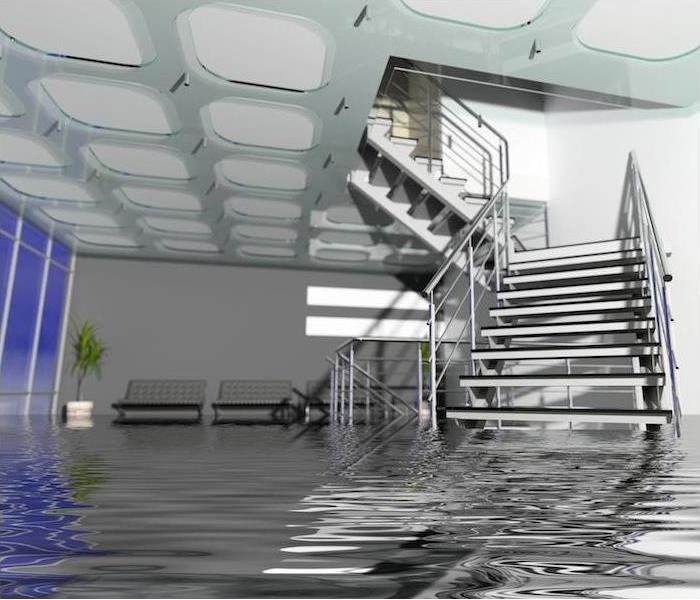 If your business has experienced a flood, we are always here to help.
If your business has experienced a flood, we are always here to help.
While flooding might seem like an isolated incident if your business is not in a floodplain, the frequency at which they can occur might surprise you. Around 90% of natural disasters involve flooding and many of the areas affected are areas that are not traditionally prone to floods at all.
It is important for business owners to take their flood risk seriously. In order to be prepared and get back to business faster, knowing how to plan for a flood is a smart business decision.
How to Prepare
By assessing your risk, planning and educating employees, and protecting your business assets in advance, business owners can ensure a faster reopening after a flood occurs. Some key things to do when preparing are:
- Check the FEMA Flood Mapto understand your risks.
- Secure your supplies and records, and consider keeping copies of them in an offsite location.
- Assemble an Emergency Action Planand ensure all employees are aware of what to do in an emergency.
- Plan an evacuation route for yourself and your employees.
- Check your business insurance policy to determine if you have flood coverage.
- Assemble a workplace emergency kit in case you and your staff must stay put and await help.
- If flooding becomes likely, move valuables and electronics to higher areas.
Documents Business Owners Should Protect
Keeping your business documents from being ruined will be extremely helpful as you rebuild your business and recover from the flood. Some suggested business documents to keep off-site include:
- Your Disaster Recovery and Business Continuity Plan
- The contact information for employees and their emergency contacts
- Insurance policies for the business
- List of any vendors, suppliers or other parties crucial to the business and how to contact them
- Computer backup recovery instructions
- Bank records and information
Call us 24⁄7 to get our team of professionals to your business quickly so you can get back on track.
The Many Hiding Places of Water Damage | SERVPRO® of Queen Anne’s, Kent & Caroline Counties
10/4/2019 (Permalink)
Considering how associated water damage is with severe weather, many are surprised to learn that it is not always the cause. There are many ways water damage can occur throughout a home and it is important to know where it commonly strikes.
Not only is discovering water damage inconvenient, but it can also be expensive. There are many insurance policies that do not accept water damage claims—for those that do, they typically amount to over $6,000. Being aware of the many hiding places of water damage can help homeowners stay aware of vulnerable spots and prevent this headache from occurring.
Where to Look for Potential Water Damage
- Below windows.Windows are joined with the exterior wall and sealed against the weather, but this seal can weaken with time. Watch for watermarks under a window to determine if this is happening.
- Below siding.The joining of siding panels can also give rise to potential leaks. Corners are especially susceptible to this, so check them often for excess water after storms.
- Below door thresholds.The metal plates at the bottom of doors are not sealed for the weather, which means water can seep into the wood below. If the threshold becomes swollen or soft, this is a good indicator.
- Below exterior paint.Layers of paint on exterior surfaces do not always seal well, creating an opportunity for water to seep into the gaps. Discoloration or softness under pressure might be a sign this is happening.
- Below the dishwasher.There are many reasons a dishwasher can begin to leak, and because they are moved so rarely, these leaks can go unnoticed for an excessive amount of time. Check behind the washer regularly for water spots.
- Inside walls with piping.The walls in bathrooms and kitchens are prime territory for leaks as the pipes within them can become worn with time. Discolored paint is the top sign for this.
- Below a toilet.Seals in a toilet can deteriorate as they age, leading to a gradual leak. This leak is often not detected until the toilet becomes wobbly due to a water-damaged floor underneath.
If your home has suffered water damage (even in a hidden place like one of these), we are happy to help! Give us a call right away, and we’ll get there quickly.
What You Need to Know About your Restoration Company | SERVPRO® of Queen Anne’s, Kent & Caroline Counties
10/1/2019 (Permalink)
By planning ahead for how they’ll handle damages, homeowners can make a stressful time much easier should they have to put their plan in action. One of the most crucial aspects of this plan is what restoration company they will work with.
By doing research and knowing the facts about their company ahead of time, homeowners can prevent unnecessary stress or confusion during the restoration process.
4 Keys to Look for in a Restoration Company
There is a lot to consider when researching restoration companies. There is a lot of information to sort through and it is easy to get overwhelmed.
However, by knowing the most important points to check for, your search will be much easier. Here’s what you need to know about your restoration company:
Damages They Can Handle
All damage scenarios vary so it will be wise to find a company that can handle a variety of issues. When situations such as toxic chemicals from fires or compromised structure from water damage occur, we are fully prepared because we maintain our certification in every type of damage.
Hours They Operate
Damages have a knack for occurring at the most inconvenient times, especially in the middle of the night. That’s why we provide a 24-hour emergency line, so our technicians can immediately spring into action as soon as damages are reported.
Levels of Training
Technicians who are well-trained are technicians you can trust to restore your home. It is important for restoration specialists to be comfortable and competent, which is why we adhere our training standards to the industry standards.
Preparedness for a Disaster
If a natural disaster occurs, restoration can move more slowly because there are many people needing assistance. Because we have a 1,700-franchise network behind us, we are able to pool our resources together when large disasters strike in order to provide exceptional service regardless of the size of the event.
If you have experienced storm damage, we are always here to help! Call our restoration experts 24⁄7 so we can address your damages quickly.
Must-Ask Questions for Your Restoration Company | SERVPRO® of Queen Anne’s, Kent & Caroline Counties
9/10/2019 (Permalink)
Property damage is always a complicated situation, but for a small business, it adds another layer of difficulty. In a recent FEMA report, it was stated that 40 to 60% of businesses do not reopen after a disaster.
Because rebuilding after a disaster is essential to business owners’ livelihood, it is important to work with a reputable commercial restoration company to get your doors reopened—but how do you know which company you can trust? We have some must-ask questions to help you determine just that.
- How Do You Handle Sudden Emergencies?
Most cases of damage can become more severe the longer they are left untreated, so a solid emergency response plan is the first thing you should look for. A company that has a dedicated emergency line and a solid emergency response time is a good indicator that you should plan on working with them.
Our own 24-hour emergency line allows us to begin taking action regardless of the time of day—meaning you can call us at any hour that you discover the damage. This allows us to respond quickly and allows business owners to get back to other recovery tasks for their business.
- How Do You Train Your Employees?
When your business is in the hands of the technicians, you want to make sure the work being done is of a high caliber. Asking how employees are trained will give you an indication of how much a company invests in its restoration staff.
Our employees are trained to the industry standards set forth by the Institute of Inspection, Cleaning and Restoration Certification (IICRC). After initial training, they are then provided with certification programs and e-learning courses to remain up-to-date and further their education.
- How Do You Choose Your Equipment?
Recent technological advancements have greatly impacted the restoration industry, meaning companies who do not keep an updated equipment fleet are immediately behind the times.
We choose our equipment based on IICRC recommendations, which guarantee our machinery is up to the industry standard. Whether we’re handling water damage, fire damage or something else at your business, we know we have the best tools for the job.
If you’re in need of commercial restoration, do not hesitate to make the call so you can get your business back faster. Our trained experts are here to help 24/7—contact us today.
Lightning: Basic Facts to Know | SERVPRO® of Queen Anne’s, Kent & Caroline Counties
9/9/2019 (Permalink)
Thunderstorms can cause damage in many ways, but one of the most violent ones is via lightning. Lightning can do more than cause fatalities—it can start fires, damage a building’s electrical wiring and lead to structural issues when it strikes. Because of the misinformation surrounding lightning, we accrued some basic facts and guidelines for preventing lightning damage.
The Origins of Lightning
As a thunderstorm is formed, it develops an electrical charge, which is what causes thunder and lightning. The lightning bolts we see are a discharge of this electrical current in the form of a bolt.
Lightning often strikes from one cloud to another, because its electrical charge is insulated within their cover. When striking toward the ground, lightning will often choose an object to pass through to simulate this insulation. Because buildings have electrical wiring and water pipes in place, they are an ideal choice for lightning to hit.
The Damages Caused by Lightning
Lighting can cause damage to a house in a number of ways, and homeowners should be aware of this and know what precautions to take.
Fires can start. Recorded as hitting temperatures up to 500,000 degrees, lightning bolts can ignite wood and other material on impact. These high temperatures can also cause lightning to damage wiring within a home’s walls, leading to electrical fires later on. If your home has been struck, the fire department may be able to test your home’s wiring to determine if it has sustained hazardous damage.
Electronics can get overloaded. A home’s typical electricity levels are nowhere near as high as the charge lightning carries, so when struck, the circuits can get overloaded with charge and pass this on to any device that’s plugged in. By using surge protectors, homeowners can protect their electronics and appliances from damage.
Structural damage can occur. Lightning striking within the clouds is what causes thunder due to the shock waves that are produced. These shock waves are also produced when lightning strikes an object or the ground, and can lead to serious structural damage due to their force. If a lightning strike has happened nearby, check the home for structural damages right away.
If your home has been affected by storm damages or lightning-related fires, give us a call today! We are experts in damage cleanup and can restore your damage quickly.





 24/7 Emergency Service
24/7 Emergency Service
